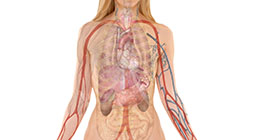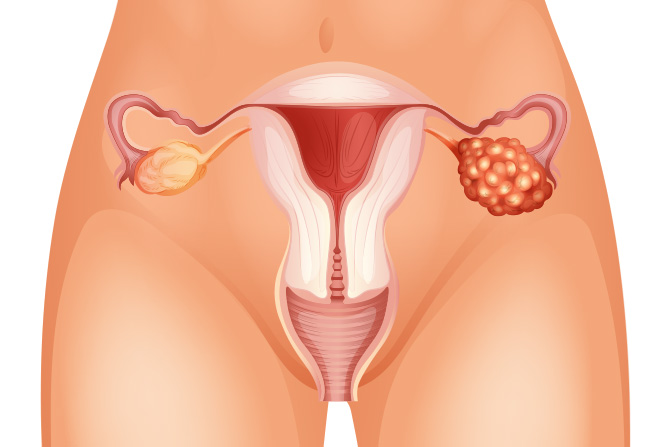Overview
Symptoms
Causes
Testing and Diagnoses
Prescription
Health Tips
Ovarian cancer is the fifth most diagnosed cancer among women in Canada. Known as the silent killer, vague symptoms make this cancer difficult to detect even while it continues invading other tissues. Ovarian cancer is more common in women who have gone through menopause, and it normally strikes women aged 50 to 79. While it is rare in women under the age of 40, it does occur. Women of Jewish or Eastern European decent are at an increased risk of developing the disease. Survival rates vary greatly depending on the type of ovarian cancer, the stage it is at when diagnosed, treatment, age and health history, but on average is 44 percent. Women need to better understand the symptoms and seek treatment earlier.
Symptoms
The symptoms of ovarian cancer mimic common illnesses and are often misdiagnosed. According to the Canadian Cancer Society, symptoms of early-stage ovarian cancer include:
- Feeling full after a light meal, bloating, and abdomen increases in size
- Feeling of incomplete evacuation of stools, gas
- Frequent need to urinate
- Indigestion
- Mild discomfort or pain in the lower part of the abdomen or pelvis
It is especially important to seek medical help if the above symptoms appear abnormal, have lasted longer than 3 weeks, are not going away, or are worsening.
Other symptoms include:
- Altered bowel movements
- Fatigue
- Weight loss
More advanced symptoms include:
- Abnormal bleeding
- Diarrhea or constipation
- Nausea, vomiting
- Painful intercourse
Causes
The exact causes are not known but there are risk factors that may increase the chances of developing ovarian cancer. Some risk factors include: BRCA gene mutations; a family history of other cancers, such as colorectal, breast, endometrial, or ovarian; obesity; not having children; IVF; hormone therapy after menopause; a sedentary lifestyle; smoking; asbestos exposure and a diet low in vegetables and high in processed foods. Talcum powder is also being studied as a potential risk factor.
Testing and Diagnoses
Tests to diagnose ovarian cancer are simple and include a transvaginal ultrasound, a CA-125 blood test, and a pelvic exam. Many doctors believe that the CA-125 blood test is not reliable, but the National Ovarian Cancer Association recommends it be given to women with the above-noted symptoms. A 1983 Harvard University study found elevated levels in 80 percent of women with stages two, three and four ovarian cancer. The test is not as reliable with stage one, missing 50 percent of early cases. Test results may also be high in women with uterine fibroids, endometriosis, liver cirrhosis, and diverticulitis, or in pregnant women. The CA-125 testing should always be used alongside an ultrasound and pelvis exam as the combination of all three will reduce the chances of false positives. Despite its imperfections, it is the best test available when combined with a transvaginal ultrasound. Fortunately, in Canada the CA-125 is covered under provincial health plans. Surgery is the only definitive method of detecting ovarian cancer. The CA-125 test is helpful during and after treatment to mark success and progression.
Prescription for Health
Diet
Eat foods that help to support the immune system, hormonal health, and that keep blood sugar balanced.
Carbohydrates – Because there is a link between cancer growth and insulin levels adopt the simple rule of not eating any white carbohydrates – white sugar, white flour, white pasta, white rice, etc. Avoid all processed foods. Processed foods contain sugars, trans-fatty acids and refined carbohydrates which take only a few minutes to cause a rapid increase in blood sugar, and a corresponding release of insulin. A complex or non-refined carbohydrate can take hours to convert to glucose and is therefore a healthier choice. Grains in their whole form make great breakfast porridges and work well in savoury meals as a rice replacement. The foods below increase the amount of fiber in the diet, which helps to keep blood sugar balanced.
- Brown rice
- Buckwheat
- Millet
- Quinoa
- Steel-cut oats or whole oat groats
- Whole grain pastas
Fats – Avoid sources of poor-quality saturated fats such as deep-fried foods (chips, crackers, doughnuts), margarine, poor-quality oils (canola, cotton seed, safflower, sunflower, peanut and soy oils), hydrogenated and trans fats. Reduce consumption of cheese and red meats. To increase intake of EPA and DHA, add regular servings of fish such as salmon, herring or mackerel.
Include:
- Avocado oil
- Borage oil (do not heat)
- Coconut oil
- Extra-virgin olive oil
- Flax oil (do not heat)
- Grass-fed butter or ghee
Protein – Avoid or greatly reduce processed meats such as hot dogs and bologna. Aside from increasing cancer risk, research has shown that eating processed meats five or more times per week is a risk factor for developing diabetes. Eat small amounts of protein throughout the day. Protein, when eaten in small amounts, inhibits the rise of glucose and stimulates glucagon to release stored carbohydrates in the liver. However, too much protein has been shown to increase insulin, especially when consumed with certain types of carbohydrates. When simple, refined carbohydrates are combined with too much protein—for example, the burger with the white flour bun—insulin increases. Consume good protein sources with excellent carbohydrate sources low on the glycemic index, while adding good fats and avoiding sugars.
Include:
- Nuts and seeds
- Organic, free-range chicken and eggs
- Organic, pasture-raised beef in small quantities
- Wild fishes (Mackerel, sardines, anchovies, salmon)
Dairy – Avoid low fat and skim milk and fruit yogurts as they are high in carbohydrates. The following organic, grass-fed items are okay in moderation for those who are not sensitive to dairy:
- Butter or ghee
- Goat’s milk, cheese, or butter
- Plain sugar-free, whole milk yogurt
Vegetables and fruit – Eat brightly coloured fruits and vegetables because they are high in vitamins and minerals and low on the glycemic index. In addition, be sure to include lots of vegetables, especially the cruciferous vegetables (cauliflower, cabbage, broccoli, Brussels sprouts) and vegetable/fruits that encourage healthy liver function, such as artichokes, rhubarb, Chinese white radish, black radish, apples, and rolled oats.
Sweeteners – Eliminate artificial sweeteners (aspartame, saccharine, sucralose) and use stevia (contains no sugars and has zero calories). Stevia has been shown to have a positive effect on the pancreas. Xylitol (which has been researched to prevent periodontal disease) is another sweetening option.
| Nutrient | Dosage | Action |
|---|---|---|
| Moducare®
(Beta-Sitosterol, Beta-Sitosterolin-Beta-D-Glucoside) |
20 mg / 0.2 mg
Adults and children 17 years and older take 1 capsules three times daily OR 2 capsules upon rising and 1 capsule before bed. |
Helps to support a healthy immune system balance; Although Moducare® has not been researched in ovarian cancer, it has been researched for breast cancer and has been found to may help to protect against estradiol-stimulated breast tumor growth. |
| Multivitamin with minerals (contains no iron) | As directed | Ensures adequate nutrient status |
| D-Chiro-Inositol | 600–1200 mg Chromium (picolinate) |
Controls and normalizes blood sugar and insulin |
| D-glucarate* | 300 mg | Important for healthy metabolism of estrogen; stops abnormal cell growth |
| Curcumin* (95% curcumin) |
100 mg | Prevents abnormal cell growth, detoxifies cancer-causing forms of estrogen |
| Indole-3-carbinol* | 300 mg | Eliminates excess toxic and cancer-causing estrogens
Has been shown to reverse abnormal PAP tests within three menstrual cycles |
| Green tea extract* | 200 mg | Protects against abnormal cell growth, detoxifies excess estrogens |
| Rosemary extract | 50 mg | Reduces tumor formation; is antioxidant |
| Di-indolylmethane (DIM)* | 100 mg | Antioxidant; reduces risk of cancer |
| Sulforaphane* | 400 mcg | Reduces risk of cancer; stops abnormal cell growth |
*Can be found in one formula
Health Tips to Enhance Healing
- Avoid hormone therapy after menopause.
- Breastfeeding for a year or more after birth may reduce the risk of ovarian cancer.
- Choose organic cotton pads, panty liners, tampons, and toilet paper.
- Cut processed foods, sugar, refined grains, trans fats, and fried foods from diet.
- Eat a diet high in vegetables, especially cruciferous vegetables, fruits, whole grains, beans, quality organic proteins and fats.











